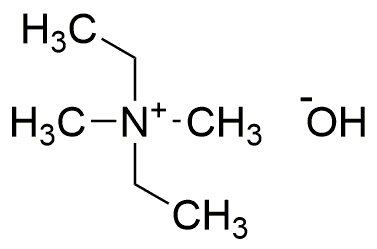Diethyldimethylammonium hydroxide solution, ~20% in H2O (AT) is widely utilized in research focused on:
- Organic Synthesis: This compound serves as a versatile reagent in organic chemistry, facilitating the synthesis of various organic compounds, including quaternary ammonium salts.
- Surface Modification: It is used in the treatment of surfaces to enhance adhesion properties in coatings and adhesives, particularly in the automotive and aerospace industries.
- Biotechnology: The solution plays a role in cell culture applications, where it can be used to modify cell surfaces for improved cell attachment and growth.
- Electrochemistry: This chemical is employed in the development of electrochemical sensors, providing enhanced sensitivity and selectivity for detecting specific analytes.
- Cleaning Agents: Its properties make it effective in formulating cleaning products, particularly for removing organic residues and contaminants in industrial settings.
General Information
Properties
Safety and Regulations
Applications
Diethyldimethylammonium hydroxide solution, ~20% in H2O (AT) is widely utilized in research focused on:
- Organic Synthesis: This compound serves as a versatile reagent in organic chemistry, facilitating the synthesis of various organic compounds, including quaternary ammonium salts.
- Surface Modification: It is used in the treatment of surfaces to enhance adhesion properties in coatings and adhesives, particularly in the automotive and aerospace industries.
- Biotechnology: The solution plays a role in cell culture applications, where it can be used to modify cell surfaces for improved cell attachment and growth.
- Electrochemistry: This chemical is employed in the development of electrochemical sensors, providing enhanced sensitivity and selectivity for detecting specific analytes.
- Cleaning Agents: Its properties make it effective in formulating cleaning products, particularly for removing organic residues and contaminants in industrial settings.
Documents
Safety Data Sheets (SDS)
The SDS provides comprehensive safety information on handling, storage, and disposal of the product.
Product Specification (PS)
The PS provides a comprehensive breakdown of the product’s properties, including chemical composition, physical state, purity, and storage requirements. It also details acceptable quality ranges and the product's intended applications.
Certificates of Analysis (COA)
Search for Certificates of Analysis (COA) by entering the products Lot Number. Lot and Batch Numbers can be found on a product’s label following the words ‘Lot’ or ‘Batch’.
Numéro de catalogue
Numéro de lot/série
Certificates Of Origin (COO)
This COO confirms the country where the product was manufactured, and also details the materials and components used in it and whether it is derived from natural, synthetic, or other specific sources. This certificate may be required for customs, trade, and regulatory compliance.
Numéro de catalogue
Numéro de lot/série
Safety Data Sheets (SDS)
The SDS provides comprehensive safety information on handling, storage, and disposal of the product.
DownloadProduct Specification (PS)
The PS provides a comprehensive breakdown of the product’s properties, including chemical composition, physical state, purity, and storage requirements. It also details acceptable quality ranges and the product's intended applications.
DownloadCertificates of Analysis (COA)
Search for Certificates of Analysis (COA) by entering the products Lot Number. Lot and Batch Numbers can be found on a product’s label following the words ‘Lot’ or ‘Batch’.
Numéro de catalogue
Numéro de lot/série
Certificates Of Origin (COO)
This COO confirms the country where the product was manufactured, and also details the materials and components used in it and whether it is derived from natural, synthetic, or other specific sources. This certificate may be required for customs, trade, and regulatory compliance.


